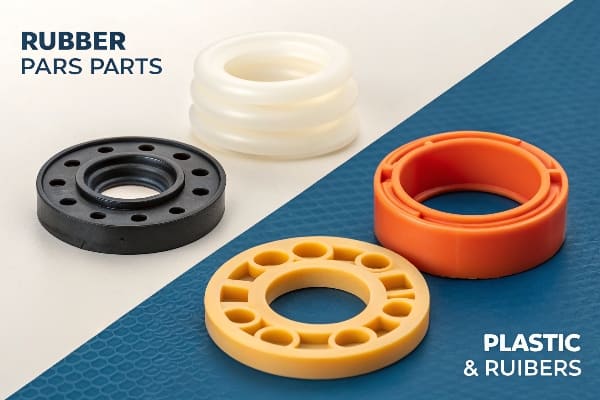When it comes to material durability1, is rubber really better than plastic? Let’s break down the differences and understand which material is more durable and why.
Rubber is often more durable than plastic due to its superior flexibility, shock absorption, and resistance to wear. However, plastic may outperform rubber in certain conditions.

In this article, we’ll explore the advantages and disadvantages of rubber, why it is considered a good material, and compare it to plastic in terms of durability, cost, and performance.
What Are the Advantages and Disadvantages of Rubber?
Rubber is known for its versatility, but like any material, it has both strengths and weaknesses. Let’s look at its advantages and disadvantages in detail.
Rubber offers excellent flexibility, shock absorption, and durability. However, it can be susceptible to degradation under certain conditions, such as extreme heat or chemical exposure.
Advantages of Rubber
-
Shock Absorption: Rubber is incredibly effective at absorbing shocks and vibrations, making it an ideal choice for applications like tires, wheels, and seals. This quality is particularly valuable in reducing wear on machines or structures.
-
Flexibility: Rubber can stretch and return to its original shape, which allows it to handle varying loads and conditions without permanently deforming. This elasticity makes rubber an excellent choice for gaskets, seals, and flexible tubing.
-
Durability: Rubber, particularly synthetic types like EPDM or Nitrile, is resistant to wear and tear, and it can withstand various environmental factors, including UV rays, extreme temperatures, and water exposure.
-
Traction and Grip: Rubber has superior friction properties, which makes it the material of choice for tires, conveyor belts, and other products requiring a firm grip or traction.
-
Noise Reduction: Rubber’s ability to absorb vibrations also leads to quieter operations, which is why it’s often used in machinery, automotive components, and furniture.
Disadvantages of Rubber
-
Heat Sensitivity: While rubber can perform well in a wide range of temperatures, it can degrade under extremely high or low temperatures. Prolonged exposure to heat can cause rubber to lose its elasticity and crack.
-
Chemical Exposure: Certain types of rubber are vulnerable to chemicals, oils, and solvents. This can weaken the material, making it less suitable for some industrial applications.
-
Cost: Rubber tends to be more expensive than plastic, which can make it less attractive for budget-sensitive projects.
-
UV Degradation: Over time, rubber can degrade when exposed to UV light, particularly if it’s not treated with UV stabilizers. This can lead to cracks and a loss of flexibility2.
Why is Rubber a Good Material?
Rubber’s unique properties make it stand out as an excellent material for many industrial and everyday applications. But what makes it so good?
Rubber is highly valued for its flexibility, shock absorption, durability, and ability to maintain performance in a variety of challenging conditions.
Key Properties of Rubber
Flexibility and Elasticity
Rubber’s most notable property is its flexibility. This elasticity allows rubber to stretch and return to its original shape, making it ideal for products like seals, gaskets, and tubing that need to compress and decompress repeatedly without damage.
- Application Example: Rubber gaskets in automotive engines or HVAC systems need to compress and seal effectively, even when exposed to high temperatures and pressure.
Shock Absorption
Rubber’s shock-absorbing capabilities make it invaluable in applications where impact resistance is needed, such as in tires, bumpers, and conveyor belts. It helps to minimize wear on equipment and surfaces while providing a smooth ride or operation.
- Application Example: Rubber tires, which absorb road shock, are a key component in vehicles, ensuring stability and comfort on uneven surfaces.
Durability and Wear Resistance
Rubber’s ability to withstand friction, pressure, and exposure to environmental factors makes it a durable material. Synthetic rubbers like EPDM and Nitrile are even more resistant to harsh conditions like UV exposure, extreme temperatures, and oils.
- Application Example: Rubber seals and hoses in industrial machinery need to withstand high pressure and temperature fluctuations without breaking down.
Temperature Resistance
While rubber can be sensitive to extreme temperatures, certain types are formulated to handle both high and low extremes. Materials like silicone rubber remain stable at temperatures as low as -60°C and as high as 250°C.
- Application Example: Silicone rubber seals in high-temperature environments, such as in ovens or engines, offer excellent heat resistance.
Rubber vs. Plastic Durability
When comparing rubber to plastic, rubber tends to be more durable in terms of flexibility and impact resistance. While plastic is more rigid and resistant to some chemicals, it lacks the elasticity and shock-absorbing qualities of rubber. For example, rubber tires outperform plastic wheels in terms of grip, shock absorption3, and traction. In contrast, plastic wheels are often more cost-effective and suitable for lighter applications, such as furniture or toys.
| Property | Rubber Wheels | Plastic Wheels |
|---|---|---|
| Shock Absorption | High | Low |
| Flexibility | High | Low |
| Durability | High | Medium |
| Temperature Resistance | High (varies by type) | Low to Medium |
| Chemical Resistance | Medium (varies by type) | High |
| Cost | Moderate to High | Low |
Rubber VS Plastic
So, when should you use rubber, and when is plastic a better choice? Let’s break down the key differences between these two materials to help you decide which is more suitable for your needs.
Rubber is generally more durable than plastic, especially for applications requiring flexibility, shock absorption, and resistance to wear. Plastic, however, can outperform rubber in certain areas like chemical resistance and cost.
Durability in Harsh Conditions
Rubber is the superior choice for high-stress environments due to its ability to absorb shocks, maintain flexibility, and resist wear. However, certain types of plastic can offer better chemical resistance, making them more suitable for environments with exposure to acids, oils, or solvents.
-
Rubber: More durable in applications requiring flexibility, impact resistance, and temperature tolerance. Common in tires, seals, and shock-absorbing materials.
-
Plastic: Offers excellent chemical and abrasion resistance but lacks the elasticity and shock absorption of rubber. Common in packaging, lightweight structures, and certain industrial applications.
Cost Comparison
Plastic is typically cheaper to produce than rubber. It’s often the material of choice in applications where cost is a major factor, and the performance requirements are less demanding.
| Performance Attribute | Rubber | Plastic |
|---|---|---|
| Flexibility | High | Low |
| Shock Absorption | High | Low |
| Chemical Resistance | Medium to High | High |
| Cost | Moderate to High | Low |
Conclusion
Rubber is generally more durable than plastic, particularly for applications where flexibility, shock absorption, and wear resistance are crucial. Plastic, while cost-effective, doesn’t match rubber in terms of performance in demanding environments.
-
Understanding the factors that influence durability can help you choose the right material for your needs. ↩
-
Learning about flexibility can enhance your knowledge of material performance in various conditions. ↩
-
Exploring shock absorption properties can guide you in selecting materials for specific applications. ↩








